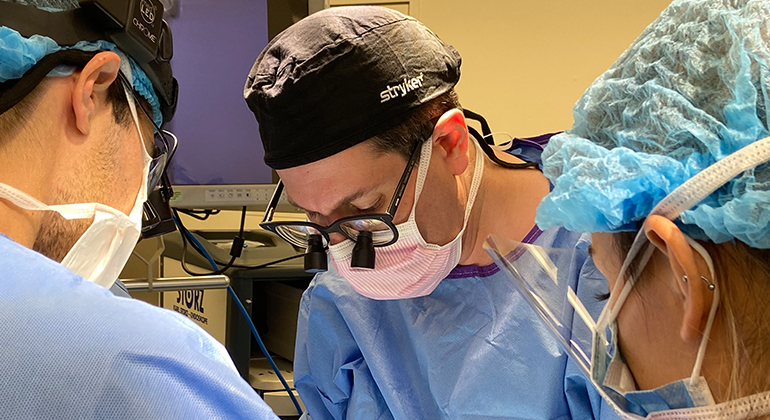Corrective Jaw Surgery for Overbites, Underbites, and Crossbites (Orthognathic Surgery)

A common procedure performed at Mount Sinai’s Division of Oral and Maxillofacial Surgery is orthognathic/corrective jaw surgery for overbites, underbites, and crossbites. Orthognathic surgery is a procedure which involves moving the upper jaw (maxilla) and lower jaw (mandible) to an anatomically correct position, which allows for a good occlusion (bite), opening of the airway and facial symmetry. Patients who require orthognathic surgery are patients that exhibit a bad bite (malocclusion), facial asymmetry or have moderate-to-severe sleep apnea. It is important to correct these conditions, as they may be the root causes for improper chewing, facial dysfunction, speech issues, joint pain, and sleep disorders.
Malocclusion and Facial Asymmetry
A minor malocclusion can be corrected with simple orthodontics. Some patients have a skeletal deformity of the jaw(s) that results in a malocclusion, which requires a combination of orthodontic and surgery to correct it. The surgery is performed on adults and teens as long as growth has been completed.
Diagnostics and Insurance Process for Orthognathic Surgery
The typical treatment sequence for the patient begins with an evaluation by the orthodontist and the oral and maxillofacial surgeon. The evaluation includes X-rays, models of the dentition, photographs, facial measurements and a complete analysis of the data to come up with a problem list and a proposed treatment plan. The team at Mount Sinai uses the most advanced 3D X-rays and computer assisted technology for their treatment planning. Once the diagnosis and surgical plan have been arrived at the information is used to communicate with the orthodontist, explain the plan to the patient and obtain insurance approval.
Virtual Surgical Planning and Surgical Guides
The virtual surgical planning (VSP) process begins with pre-operative orthodontic therapy. The goal of the orthodontic treatment is to level and align the teeth over the maxillary and mandibular bony arches. This phase can take 12 to 18 months. When the patient is ready for surgery, a complete workup is performed with the use of Cone Beam 3D CT scan and 3D photomorphometry, allowing for Virtual Surgical Planning (VSP) of the procedure. VSP is an extremely accurate tool that allows the surgeon to perform or “rehearse” the surgery in a virtual environment prior to performing the actual procedure in the operating room. It also helps predict the outcome of the procedure, and is a powerful tool used for the design and fabrication of surgical guides using 3D printers to ensure the accurate transfer of the VSP to the operating room.
The orthognathic procedure is performed under general anesthesia in the operating room with the braces in place. Internal fixation devices (small titanium screws and plates) are used to connect the repositioned segments to the jaws. Patients routinely stay in the hospital for approximately 1 to 2 days. Following the procedure it is common to use training elastics from the upper jaw orthodontic appliances to the lower jaw appliances to help retrain the patients to close into their new bites. The patient’s diet is limited to a liquid or non-chew diet for four weeks to allow for undisturbed healing of the osteotomies.
Patients return to the orthodontist 6 to 8 weeks after the surgical procedure to start the post-operative orthodontic phase to “fine tune” and perfect the final occlusion. This phase can last from 3 to 6 months, and helps ensure long term stability of the dentition and repositioned bone. The oral and maxillofacial surgeon will continue to follow the patients over time to monitor the outcome and identify and manage any relapse of the treatment.
Orthognathic Surgery for Sleep Apnea
In addition to treating overbites, underbites, and crossbites, orthognathic surgery is also performed to correct moderate–to-severe sleep apnea. The procedure is known as maxillary and mandibular advancement, which is the process of moving the upper and lower jaws forward to increase the airway space. This increase in volume of the oral pharyngeal airway will often decrease the amount of snoring and apneic episodes experienced overnight, therefore eliminating the need for a CPAP device.